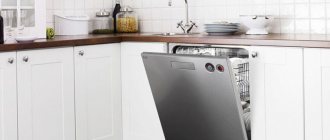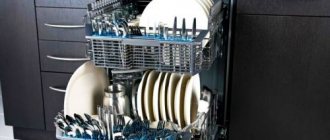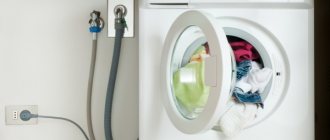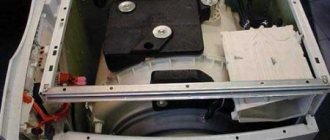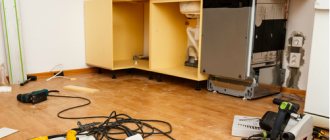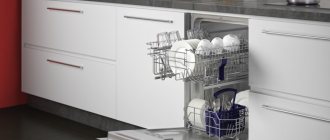How to install a dryer: 3 placement methods
Next, we will analyze the vertical, horizontal arrangement and under the tabletop.
Vertical placement
Optimal for small apartment spaces. The dryer is mounted upright in a column with a washing machine. Both devices should be the same width for good stability. When installing, the dryer should be above the washing machine and not vice versa. The washing machine is heavier and produces more vibration during washing.
Installation occurs using fastening parts (included). They make the dryer stationary, protect it from tipping over, and the washing machine from vibration damage.
Installation diagram:
- place the washing machine on a flat surface, leaving a gap of a couple of centimeters from the wall (due to its vibration characteristics);
- Place a stand on top of the washing machine on which the dryer will be installed;
- Fill the space between the washer lid and the stand with rubber gaskets;
- you will need bolts to secure the stand;
- the dryer should fit its legs into the existing grooves on the stand;
- Close the fastening openings with a plug.
Although this method increases space, installation is not easy. You need to take into account safety rules and installation recommendations; Adjust the dryer to the desired location only with fasteners.
Attention : do not put the dryer and washing machine into operation at the same time. There is a risk of the unit tipping over during operation due to vibration, even when secured.
When making renovations in an apartment, you can think through the installation of the dryer in advance by designing a plasterboard niche for the desired model.
Horizontal installation
Provides maximum stability of the unit. The dryer is installed at the same level as the washing machine, so the room must be spacious. In this case, you will need to adjust the length of the legs and level the equipment at the same level.
Under the countertop or sink
If the machine is not large, you can place it under the sink or countertop. It is worth considering that it is better to install the condensation model next to the sewer to simplify the connection of the dryer to the drain.
To work, you will have to stock up on a standard set of tools, and the necessary parts for the device must be included in the package provided by the manufacturer.
1. Knife for construction For cutting hoses (hereinafter referred to as tubes), (water or air). 2. Clamps To fix the corrugation. You can remove air through a soft corrugated tube using plastic clamps. 3. Pliers and screwdriver To secure/clamp the clamp (metal).
In addition to the basic elements, you may need to acquire a hammer drill (to enlarge the opening in the wall), a hacksaw for cutting metal and scissors for plumbing pipes.
Interesting article: How to choose the right dryer, Or which one is better in everyday life: 5 practical tips
Connecting a clothes dryer to the sewer: how to connect, what you need, instructions
A dryer is a household appliance that is designed for quickly and comfortably drying wet things. Externally, this device is very similar to a standard washing machine, with the exception of the absence of washing modes and the presence of drying modes.
There are several types of drying machines:
- Drying cabinet;
- Drum type.
A drying cabinet is more difficult to use and will require hanging washed items in special places for drying (this must be done manually). The process of removing excess moisture from the fabric occurs due to fans that supply air to the drying chamber. Also, the process uses heating elements for the air itself - air (electric) heaters. For this type of dryer, connecting to a sewer is not necessary. A standard spin mode in the washing machine or doing it manually will be enough, after which the items can be moved to the drying cabinet.
Drum type - similar to the operating principle and design of a drying cabinet, with the exception of the key element - the presence of a drum for things. This type of drum promotes faster drying and allows better penetration of hot air into the fabric. Also, the drum type reduces the need for subsequent ironing of things.
Thanks to special programs for rotation, things do not wrinkle. For the drum type, connection to the sewer is also not necessary, but it is more preferable if you do not have the opportunity to load things that have been wrung out from moisture, and then pour unnecessary water from reservoirs to collect it.
The type of drying can be divided into:
Condenser. Heated air, together with water, condenses on special elements inside the device and flows into special containers. This water no longer ends up on things, but is extracted (manually or down the drain) from the drying process. It is better not to water your house plants with this liquid - it may contain substances from washing powder that are harmful to plants.
Ventilation. The heated air carries the “humidity” outside the car. This is the simplest drying method, but it requires sufficient ventilation around the machine and can spoil the surrounding area with excess moisture.
Some models of dryers have additional elements - these are infrared lamps that disinfect laundry, an air ionizer that makes things safer for human health, and others. All these elements are additional (minor) and only enhance and bring comfort to the basic principle of operation.
How to connect the dryer:
Connecting the dryer to the sewer and power supply yourself, or with the help of a specialist?
IMPORTANT! If you decide to connect your dryer to sewerage and power, you need to think carefully about the installation process.
An experienced master will be able to guarantee the quality of the work done, complete the work quickly and give the necessary recommendations for operation that will protect you from breakdowns. However, this will require spending personal time searching and ordering a master, and will require spending money to pay for his work. You need to seek the help of a professional when you have no idea how to connect a clothes dryer.
Do-it-yourself installation is a viable option if you have even limited plumbing and construction skills. The clothes dryer is connected in the standard way: using a special drainage system, connected to the sewerage system, power supply - installation is carried out in the standard way (install an outlet nearby or use a carrier). Ready.
What tools are needed?
To connect, you need not only to know how the dryer is connected, but also to have the following tools:
Knife
Using a knife, you can cut the drainage system to the required length. The drainage system can be sold separately or come together with the dryer. When purchasing it yourself, make sure of the quality of the product.
Drainage clamps
Sold at any hardware store. They are a metal strap with a tightening locking mechanism.
Installation of a condenser dryer
Installing a condenser dryer is suitable for rooms with a weak ventilation system due to the nature of the equipment.
The operating principle is based on “three pillars”:
- warm air under pressure is directed into the drum, which is in a rotating state;
- the air draws moisture from the laundry, after which it goes to the heat exchanger; Here it cools, turns into condensate, flowing into the container.
Moisture must be drained after each use. Therefore, cold air in the room is the optimal solution for condensation-type machines. In a draft, the dryer uses more energy.
Models such as Candy are easy to install and do not require outlet pipes. They can be installed on the floor, built into a cabinet, column, or installed on a washing machine.
Instructions:
- Turn off the power supply.
- Either draw a separate line from the electrical panel, or use a grounded outlet.
- Protect the electrical network from current leakage (RCD). Connect a 16A RCD and the same circuit breaker to the panel. An automatic switch will be needed for the unit to protect the dryer from damage during power surges.
- With dry hands, plug the dryer into the electrical outlet.
Attention : it is not recommended to turn on the washer and dryer in one double outlet. There may be a risk of melting and short-circuiting the socket.
When installing in a kitchen or bathroom, care must be taken to ensure that no water gets into the outlet.
On topic: Instructions for the washing machine: 7 secrets of effective use of equipment
Machine installation options
In line (in a row)
You can install a washing machine and dryer nearby where there are conditions for this and enough space (in the kitchen, bathroom, dressing room, hallway). With this arrangement, the upper surfaces of the two machines create an area that can be used advantageously. Build a tabletop on top, and you can hang a wall cabinet or shelf on top.
In order to save space, it is also a good option to install equipment in the kitchen unit under the worktop.
In a column (vertically)
Also, in order to save square meters, it is widely practiced to install appliances one on top of the other: at the bottom – a washing machine; at the top there is a dryer (the other way around is not allowed in any case!).
An excellent solution for installing a dryer
A washing machine weighs much more than a dryer and is therefore always installed from below. Moreover, the floor must be smooth and durable (preferably concrete). Any uneven, soft (carpeting), slippery (linoleum) or wobbly surface (sagging plank flooring) will contribute to the already strong vibration of the unit.
To ensure that the dryer installed on top does not slip onto the floor during operation, you will have to work hard yourself, but if you do not have experience, it is better to contact a specialist.
Anti-tip fastenings and special parts (caps) are installed on the body of the washing machine. A dryer is installed in them. The stability of such a structure must be absolutely reliable and not raise the slightest doubt.
Another mounting method: the dryer can be mounted on the wall above the washing machine.
dryer on the wall
In both cases, installation requires special knowledge and skills. Therefore, entrust this work to professionals.
Installing a dryer on a washing machine without special fastening is completely unacceptable and simply prohibited!
If you are planning a renovation, you can prepare a place for the devices in advance. Use drywall to build a special niche for installing both machines.
There are small compact models of drying devices designed for only 3 kilograms of laundry. Such equipment can simply be placed on top of the table or recessed into a niche in the kitchen unit.
Installation of a hood dryer
Drying occurs by removing moist air into the ventilation system. The Beko DA7011PA dryer is connected to a ventilation system or pipes leading outside with a turbocharged hood.
The operating principle is simple: the laundry in the drum is treated with (hot) air. After which the air is discharged through the corrugated tube.
Before activating the dryer, check the length of the tube in relation to the distance from the installation location of the equipment to the outlet hole.
Installation of an exhaust dryer.
- A flexible tube connects to the vent on the side of the dryer body.
- To tie the tube, use a clamp, tighten it with a screwdriver, using pliers - clamp it at the end until it stops.
- The second end of the corrugation goes to the central ventilation system. The junction must be secured with a clamp. The height at which the tube can be in the outlet hole should not be less than 0.5 m.
- Then turn on the dryer for a test run.
Attention : do not bend or turn the corrugation 90 degrees, otherwise the hood will work weakly, poorly removing humidified air.
It is contraindicated to route the air duct through the top if there is a high degree of heat in the place where the dryer will be installed. Risk: condensation builds up, preventing air flow. The correct solution is a wall hole opposite the dryer outlet.
Placing dryers with built-in powerful fans requires the outlet pipe to be led out into a window (if it is not possible to connect to the ventilation shaft).
Educational article: How a washing machine works: the design and operating principle of the machine. 5 main washing steps
How to connect a dryer to the sewer?
A dryer is a household appliance that is designed for quickly and comfortably drying wet things. Externally, this device is very similar to a standard washing machine, with the exception of the absence of washing modes and the presence of drying modes.
There are several types of drying machines:
- Drying cabinet;
- Drum type.
A drying cabinet is more difficult to use and will require hanging washed items in special places for drying (this must be done manually). The process of removing excess moisture from the fabric occurs due to fans that supply air to the drying chamber. Also, the process uses heating elements for the air itself - air (electric) heaters. For this type of dryer, connecting to a sewer is not necessary. A standard spin mode in the washing machine or doing it manually will be enough, after which the items can be moved to the drying cabinet.
Drum type - similar to the operating principle and design of a drying cabinet, with the exception of the key element - the presence of a drum for things. This type of drum promotes faster drying and allows better penetration of hot air into the fabric. Also, the drum type reduces the need for subsequent ironing of things.
Thanks to special programs for rotation, things do not wrinkle. For the drum type, connection to the sewer is also not necessary, but it is more preferable if you do not have the opportunity to load things that have been wrung out from moisture, and then pour unnecessary water from reservoirs to collect it.
The type of drying can be divided into:
Condenser. Heated air, together with water, condenses on special elements inside the device and flows into special containers. This water no longer ends up on things, but is extracted (manually or down the drain) from the drying process. It is better not to water your house plants with this liquid - it may contain substances from washing powder that are harmful to plants.
Ventilation. The heated air carries the “humidity” outside the car. This is the simplest drying method, but it requires sufficient ventilation around the machine and can spoil the surrounding area with excess moisture.
Some models of dryers have additional elements - these are infrared lamps that disinfect laundry, an air ionizer that makes things safer for human health, and others. All these elements are additional (minor) and only enhance and bring comfort to the basic principle of operation.
How to connect a clothes dryer with your own hands?
To facilitate and speed up routine household processes, people turn to the help of household appliances. Units for fast, high-quality drying of washed clothes are as necessary at home today as washing machines. Such devices can thoroughly dry a large volume of wet things in a short period of time.
Installing a heat pump dryer
The operation is similar to the condensation type. The difference is in the humid air. It passes through the evaporator and then into the sewer pipes, without any remaining moisture in the tray. The drain pipe will be needed as a connecting element to the sewer.
Connecting a dryer with a heat pump.
- The manufacturer provides for securing the tube at one end in the body of the equipment (as in the washing machine).
- The second end is connected to the sewer (or installed in the toilet or sink).
You can prevent water leakage during connection using a tee (it is built into a plastic drain pipe). The thickness of the hose and the tee pipe must be the same size.
Attention : to merge the pipe with the hose, use a plastic tip. A metal clamp with a rubber gasket is suitable for fastening. Needed to avoid damage to the tube.
This connection method increases the service life of the equipment. Removing excess water prevents corrosion of metal elements and damage to rubber.
Educational article: Which washing machine is better - vertical or frontal: 5 differences
Comparative characteristics of dryer types: table
| Condensation | Exhaust | With heat pump | |||
| + | — | + | — | + | — |
| — mobile installation, powered by electricity; | — reduces the service life of the machine (excess water is inside the equipment). | - rarely breaks; | — requires connection to external communications; | — extends the service life of the dryer; | — connects to external communications; |
| — mounting on the floor, in a built-in closet, on a washing machine; | - inexpensive; | — suitable for installation in a spacious room (preferably in a country house); | — modern, energy-efficient model (saving up to 50% of electricity); | - not cheap | |
| — budget; | - quick drying of clothes | - outdated version | — reduction of drying cycle | ||
| — no connection to external communications | |||||
Now you are notified how to connect the dryer. You can negotiate with a specialist or do it yourself at your own risk. When connecting, any type of dryer has its own characteristics. But there shouldn't be any difficulties. Just follow the instructions and our advice.
Read: Tumble dryer or washer-dryer - which is better: 7-point analysis
Types of installation
Today ]household appliances[/anchor] can present to your attention several types of clothes drying machines:
- Exhaust;
- Condensation;
- With a heat pump.
For example, exhaust units can dry your laundry by venting air into the ventilation duct. Condensation products will force air through the laundry chamber. Then the moisture will settle in a special tray. The tray must be cleaned after each use of the dryer. Machines with a heat pump will work in a similar situation to the previous option. Their main difference will be that the air will not pass through the heat exchanger, but through the evaporator.
In private homes, exhaust dryers are usually installed. They will need to be connected to ventilation and electricity. If you do not have the opportunity to connect this type of dryer, then you can connect a condensing dryer. It can drain water into a tray or into a sewer.
You can see the functionality of these models in the video example.

